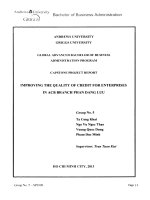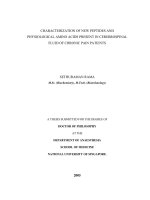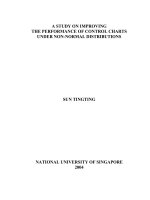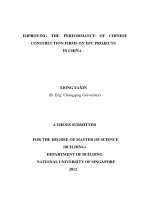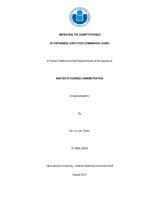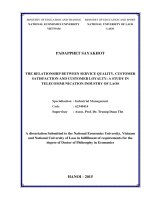Improving the competition and business monopoly control policy in Vietnam in the context of international economic integration
Bạn đang xem bản rút gọn của tài liệu. Xem và tải ngay bản đầy đủ của tài liệu tại đây (382.29 KB, 12 trang )
1
2
INTRODUCTION
in order to create a fair, equal and efficient business and competitive
environment and implement international commitments. So, it is necessary
to depend on content and criteria of analysis to review, evaluate the
policies, and propose contents which require amendment or supplements in
order to improve these policies in Vietnam.
From the overall objective, I have defined detailed objectives of my
study: (i) Analyze and evaluate policies having direct impacts (through
legal institutions and regulations) and policies having indirect impacts (for
support or protection) through such policies as tax, anti-dumping, import
and export and State credit, etc. on competition and monopoly control in
order to fulfill the objective of promoting role of the State in creating an
environment of free trade, free competition, non-discrimination which is
the fundamental principle of competition and (ii) Introduce lessons learned
from some countries to Vietnam.
In order to achieve the above objectives, following issues are required
to be included in the study:
• What
are competition policy and competition law? Their
relationship?
• Institution of competition and monopoly control policy? Why is
competition law the most basic and important component of the
competition policy?
• Fundamental basis and basic content of competition policy and
competition law?
• Which criteria are used to analyze and evaluate the competition and
monopoly control policy in Vietnam?
• What is the suitable level for State’s intervention for adjusting
competition and monopoly control?
• Why is it necessary to form and maintain a fair and efficient
competitive environment? What to do? What is the State’s role relating to
this issue?
• Why is it necessary to amend and improve the competition and
monopoly control policy in the global economy and international economic
integration?
1. Reasons to choose the topic
Competition is the classic nature of the market economy, is the driving
forces behind the socio-economic development, bringing about numerous
benefits to the customers. But monopoly is a form of market structure
which is formed by many different causes and has impacts on the whole
society and prevent competition, etc.
In order to maintain competitive environment and overcome the
limitations of monopoly, role of the State through a system of competition
policies and laws on monopoly control is very important and crucial.
In recent time, the system of such policies in Vietnam does not
properly reflect laws of movement of the market economy. It still contains
patches, inconsistencies, passive responses and follows the “real arising
problems”. In particular, in the current context of increasingly deep
globalization and international economic integration, there are still many
problems relating to the current system of competition and monopoly
control policy on Vietnam.
From this situation as well as its urgency and topicality, I decide to
carry out my doctoral dissertation on “Improving the competition and
business monopoly control policy in Vietnam in the context of
international economic integration”.
2. Purpose of the study
On the basis of synthesis and clearer interpretation of the relationships
between competition and monopoly, between competition policy and
monopoly control one, in which competition and monopoly control law
forms an important part of competition policy. In addition, based on the
analysis results and situation assessment as well as reference to experience
drawn from some countries in the world, and changes of the global
environment, I would like to propose the State to amend, supplement and
adjust a number of sanctions and legal regulations in order to improve the
competition and business monopoly control policy in Vietnam. From these
issues, I has defined the overall objective of my study is to promote the
State’s role through a system of competition and monopoly control policies
3
4
3. Objects and scope of the study
(i) Objects of the study
• The competition policy with the main approach on its important
content and component which is competition and monopoly control law.
• In order to achieve the above objective, the object of the study is an
overall analysis and assessment of competition and business monopoly
control policy in Vietnam will real evidences taken from manufacturing
and service sectors. The study will approach and consider the issues under
the perspective of competition policies, i.e. consider monopolization,
barriers to market entry and exit, economic concentration level, practices in
restraint of competition and unfair competition. These are important
content or component of competition policy and competition law. My
study uses 5 common criteria and component criteria to analyze and
evaluate the policy, namely (1) Market scope, (2) Restraints in competition
and market entry, (3) Market structure, (4) Current competition institution
and policy, (5) Current competition situation and identification of anticompetition practices.
• Study experience learned from some countries in terms of
competition policy and law. Useful lessons for Vietnam.
• Some enterprises and economic groups are included and briefly
analyzed in my study as the direct beneficials of competition policy and
law, contributing to the improvement of the policy.
(ii) Study scope
• Analyze and evaluate the competition and monopoly control policy
in Vietnam through the 4 basic contents and 5 criteria as presented above.
• Analyze and identify the positive factors contributing to competition
promotion and restraints of competition, especially ones arising from
regulations, institutions and policies of the Government.
• Evidences taken from 2 manufacturing and service sectors of cement
and petroleum in Vietnam will be included in the study.
• Situations, figures and periods included in the study are taken during
4-5 recent years, especially after the international economic integration and
after Vietnam officially became the 150th member of WTO.
4. Study method and references
(i) Study method
My dissertation contains following study methods:
- Comparative and statistical analysis method
- Systematic analysis method
- Qualitative and selective inheritance method
- Diagram and graph method (charts)
- Unique study methods of economics: marginal and optimal selection
method, positivist and normative method, etc.
(ii) Study references
• Documents and policies related to the topic of the study of some
countries in the region and all over the world.
• Documents and policies on competition and monopoly control in
Vietnam such as Competition Law, Bankruptcy Law, Decree No.
116/2005/ND-CP, Decree No. 120/2005/ND-CP, Decree No. 05/2006/NDCP, Decree No. 06/2006/Nð-CP, annual reports of VCCI and Competition
Management Authority (Ministry of Trade and Industry) and some
specialized laws, etc.
• Scientific summary records, economic magazines and internet.
5. Scientific contributions of the dissertation
(i) General contributions of the dissertation
Contributions of the dissertation are presented in the objectives of the
study. Following is further interpretation.
1 In order to improve the competition and monopoly control policy, it
is necessary to continue renewing awareness and conception about
competition and monopoly, about the relationship between the State and
market, avoid restraints in competition and fostering monopoly.
2 The market economy will operate in accordance with its rules and
mechanisms, without any impact on the role of the State. The State still
plays an important role in creating the environment and regulates the
behaviors of the economic agents through legal regulations on competition
and monopoly control.
3 Reasonably solve the relationship the level of the State’s adjustment
between maintaining competition and restraining monopoly, eliminating
monopoly. There is no presence of monopoly in a competitive environment.
5
6
4 Experience of other countries in terms of design, construction,
operation, amendment and supplements of competition policy and law,
monopoly control and anti-monopoly law is useful lesson and reference for
Vietnam.
(ii) Specific contributions of the dissertation
1.
The dissertation has found out that in the contemporary
economy and globalization which contains the development of the “Digital
economy” and of “flat world” whose key element is establishment of the
global supply chain and changes in the market structure, there are two kinds
of markets: competitive market and non-competitive one. The competitive
market consists of for-profit businesses while the non-competitive market
consists of non-profit businesses and ones which are established under the
“Blue Ocean Strategy”.
2. The dissertation has analyzed and made some recommendations: in
order to create and maintain a competitive environment, it is required to
control monopoly, implement legal regulations, sanctions and measures of
the competition policy whose most important component is competition law
which is a Code of the State consisting of civil and criminal regulations in
order to prevent anti-competition practices. Only by that, the equality, nondiscrimination, free trade and competition are ensured, because they are the
nature as well as the fundamental basis of competition policy and
competition law.
3. The competition policy and other economic policies have an
interdependent relationship, “no policy is a separate island”. The
interdependent relationship has impact on the economic operation and
competitive environment. So, I recommend: it is necessary to carry out a
scientific analysis and assessment of competition policy, including relevant
policies before and after the policy is implemented, in order to ensure its
consistency and efficiency; and also overcome the shortcomings,
overlapping, patches and following of the “real situation” the policies. In the
dissertation, I also recommend: improving and adding common criteria,
component criteria and auxiliary criteria which should be used together in
analyzing and evaluating the policy.
4. In the current context of global economy, there appear many changes
after the financial and public debt crisis. Mergers and Acquisitions (M&A)
in ASEAN and Vietnam have been enjoying a strong development and
growth. This is the potential factor leading to an establishment of a market
dominance and impact on the competitive environment. Therefore, in my
dissertation, I recommend controlling the economic concentration through
institutions and legal regulations should be the most important component of
the competition policy.
5. With the new trend of current integration and development, in the
dissertation, I recommend: The State should make a change in the direction
of reducing the function of “State doing business” and strengthening
“Welfare State”, “Legitimate State”; implementing and “imposing”
competitive market to all enterprises, including SOEs to ensure an fair
“playground” and effectively use all social resources.
6. In order to create and maintain the fair competitive environment, in
the dissertation, I recommend the State to make a simultaneous application
of both types of policies: the policies of direct impact through institutions
and legal regulations, and the ones of indirect impact such as tax, import and
export, anti-dumping and credit, etc. in order to support or protect the
domestic enterprises.
7. Based on the experience in construction of model of competition
management authorities of some countries, the urgency of real operation in
Vietnam, especially settlement of violations of competition law which contains
several shortcomings, overlapping, takes long time and have low efficiency, in
the dissertation, I recommend: merging 2 current competition authorities
(Vietnam Competition Authority and Vietnam Competition Council) into one
single competition authority (the National Competition Commission which is
under direct management of the Government) which occupies a higher legal
position and corresponds to its assigned functions and tasks.
6. Structure of the dissertation
In addition to the introduction, conclusion, table of contents,
appendices and references, the dissertation consists of 4 chapters:
Chapter 1: Overview of the research
Chapter 2: The basic theories on competition and monopoly control policy
Chapter 3: Situation of competition – monopoly and adjustment
policies in Vietnam
Chapter 4: Viewpoints and solutions for improving the competition
and business monopoly policy in Vietnam
7
8
CHAPTER 1. OVERVIEW OF THE RESEARCH
I also propose 5 issues for further study:
1 Competition and monopoly control policy should indicate changes
in viewpoints and meeting the specified requirements and objectives; 2
No attention to raising opponent comments to the policy, conducting a
scientific analysis and assessment of the policy before and after its
implementation; 3 Use of common criteria and component criteria in
combination with other relevant factors to analyze and evaluate the policy;
4 Settlement of violations of competition law, and 5 “Characteristic”
settlement of monopolies in Vietnam still contains several disputes.
The chapter 1 consists of 3 parts: (i) research objectives, (ii)
Classification of researches based on forms of publication and (iii) Overall
assessment. Here is the basic content:
Overview of the research is the summary, assessment and comparison
of research works relating to the topic of the dissertation so that I could
identify “gaps” and “missing” questions for study. Accordingly, I have
classified the research works into 3 main categories: (1) reference books /
monographs, (2) Annual Reports of ministries / sectors, and (3) Summary
reports, magazines, and scientific works.
Based on analysis and assessment of above types of works, I have
concluded that: (i) Despite different approaches of works, they share the same
criteria of assessment and show the nature of competition and monopoly; (ii)
the research works contain consistencies between theories and practices,
shortcomings and restraints in competition and monopoly control, antimonopoly; (iii) competition law mentions 3 main issues: 1 abuses of market
dominance, 2 competition restriction agreements, and 3 regulation on
control of economic concentration level. Position of competition laws in the
competition policy is shown in the following model:
Competition
policy applied to
a specific
sector/market
> Trade and protection
> Trade policy
> Intellectual property
> Consideration for merger
> competition restriction
agreements
> Abuse of market
> Protection by the State
> Natural monopoly
> Sensitive industries
Policies affecting
competition
COMPETITION
LAW
Regulating
rules
CHAPTER 2. BASIC THEORIES ON COMPETITION AND
MONOPOLY CONTROL POLICY
Chapter 2 consists of: (i) Competition and monopoly, (ii) Law on
competition and monopoly control, (iii) Role of State Management
Authorities in competition and (iv) experience of foreign countries and
lessons for Vietnam. This chapter presents the following major contents:
nature, criteria for competition classification and impact of competition.
Competition is a classic issue, a property and a rule of the market
economy. In the contemporary market economy, there are two kinds of
markets: there are two kinds of markets: competitive market (consisting of
competitive enterprises) and non-competitive one (consisting of enterprises
of public benefits, enterprises of social security and ones formed under the
“Blue Ocean Strategy”). Competition and monopoly have a causal inverse
relationship. Dispite of causes of its establishment, the monopoly has
negative impact on the whole society and customers as well. Therefore,
Vietnam and many other countries all over the world consider antimonopoly and monopoly control the most important task of their States. The
important and effective legal instrument for the State to carry out their task
is competition and monopoly control policy because the competition law is
law of anti-monopoly and competition maintenance. There will be no
Market structure
Business’ behaviors
Socio-economic policies
9
10
presence of monopoly in a competitive environment! In terms of theory, I
have presented 4 main contents and 5 common criteria as well as the
component criteria to analyze and evaluate the competition policy in order
to ensure high consistency, logic and accuracy. In terms of organization, the
state management authorities must be organized in an independent,
Its indirect impacts are indicated through such policies as tax, anti-dumping,
import and export and state credit, etc. in order to support and protect
industries and enterprises in Vietnam.
From the above content and issues, I would like to present here my
specific assessment (strengths and limitations) in policy implementation as
following:
1 Awareness and conception
There is a change in awareness and conception about the operational
rules and mechanisms of the market economy and the fundamental
principle of competition is non-discrimination, free competition, free trade,
free market entry and exit. We also see the role of the State through a
system of competition policies and laws on monopoly control, as well as
enterprises – its beneficials.
professional manner. They should occupy a high legal position which
corresponds to their function and responsibilities and should be operated
under the direct management of the Government. They also should be
provided with sufficient conditions for well operation. Lessons learned from
other countries, especially those which share similarities with Vietnam
defined in this chapter are a very useful reference for Vietnam.
CHAPTER 3. SITUATION OF COMPETITION – MONOPOLY
AND ADJUSTMENT POLICIES IN VIETNAM
Total number
of enterprises
700
622.977
600
This chapter consists of: (i) situation of competition and monopoly, (ii)
Situation of competition and monopoly control law and (iii) Overall
assessment of competition and monopoly control policy.
This chapter primarily aims to provide an overall assessment of real
situation of competition and monopoly; the implementation of the competition
and monopoly control policy after 6 years since the Competition law became
effective (July 1, 205) in Vietnam.
The above criteria and content have been used to conduct the analysis
and assessment of the situation. Here, I specially base on number of
enterprises (market size), identification of positive factors promoting
competition as well as restraints in competition arising from legal
regulations, institutions and policies made by the Government, economic
concentration level and monopolization, restraints in market entry and exit,
unfair competitive practices, etc., which means a identification and
assessment of direct and indirect impacts of the polity on competition and
monopoly control. The policy has direct impacts on competition and
monopoly control through regulations and sanctions of the competition law.
544.394
500
455.207
400
370.676
305.358
300
290.767
246.451
248.757
205.689
199.788
200
112.95
155.771
131.318
100
Year
0
2005
2006
2007
Total number of registered enterprises
2008
2009
2010
2011
Total number of operating enterprises under survey of GSO
Source: - General Statistics Office and Agency of business registration
- Vietnam enterprise annual report - VCCI in 2011, page 22
Figure 3.1: Total number of registered enterprises and operating prices
as at December 31 of years from 2005-2011
11
12
The figure 3.1 shows that there are a large number of enterprises with
high potentials for competition in the Vietnam market, and accordingly, the
competition among competitors have become increasingly fierce and
aggressive. However, from such competition, there happen numerous
competitive practices have impacts on legal rights of other economic agents
and the society. Following are some typical examples of unfair competitive
practices which have been settled by the Competition Law (from Article 40 to
Article 49). Specifically, in 2006: 1 case; 2007: 5 cases; 2008: 13 cases; 2009:
14 cases and 2010: 28 cases. In which 46/63 cases have investigation was
unfair competitive practices in the Vietnam market.
2 Policies of direct impacts
(i) Legal regulations on competition restriction agreements
Although the competition restriction agreements have been specified
in the Competition Law; Decree No. 116/2005/ND-CP detailing the
implementation of a number of articles of the Competition Law and Decree
No. 120/2005/ND-CP on dealing with breaches in the competition law,
etc., many breaches still appear in the market. 3 cases relating to “price
initiated by the Vietnam Competition Authority and 15/61 cases
investigation based on complaints from enterprises, including 21
relating to advertising; 17 ones relating to illegal multi-level sales; 6
relating to promotion; 4 ones of misunderstanding instructions; 1
have
cases
cases
cases
relating to business disruptive practices, etc.
(iii) Legal regulations on abuse of market dominance and monopoly
In 2009, the Vietnam Competition Authority conducted eight
investigations concerning abuse of market dominance/monopoly position,
in which only one was realized in accordance with regulations of
competition law. Its main reasons are competition authorities, awareness of
enterprises and regulations of the Competition Law.
maintenance agreements” in the automobile physical damage insurance
market, roof plate market and student insurance market are typical
examples. Relating to the competition restriction agreements, there are
some regulations which are just inflexible principles, do not approach the
anti-competition nature of the case, especially sophisticated ones made by
the enterprises. Specifically, Article 9 of the Competition Law is
unreasonable. Normally, any agreements on price fixing, market division,
output restriction and auction collusions which always contain anticompetition should be prohibited and not be exempted. But in fact, there is
no regulation on such agreements, leading to many difficulties in
settlement. By law, such agreements are prohibited only the combined
market share accounts for 30% or more, but in fact, many cases in which
the combined market share accounts for less than 30% still leads to an
increase in price and price maintenance. So, how to settle the situation is
A typical example of this behavior is the dispute on fuel price between
the Vietnam Air Petrol Company (Vinapco) and Jetstar Airways Pty Ltd.
on April 1, 2008 which was settled by the National Competition Council
with the final conclusion: Vinapco was fined for more than 3.3 billion
VND, but there have been several controversies around the dispute. Its
direct cause was that the two parties reached no agreement in fuel price.
Vinapco stopped providing petroleum to Jetstar Pacific, leading to its nonoperation, and then Vinapco accused Jetstar Pacific of not paying for
petroleum and forcedly stopped its supply of petroleum. In addition, there
are many other cases relating to movies distribution and showing,
very difficult?
telecommunications, electricity, cement and so on.
(ii) Legal regulations on unfair competitive practices.
Due to inconsistency, patches in the competition mechanism and policy
of Vietnam, the market is still affected and driven by law of value, law of
supply and demand and law of competition. Therefore, any unfair
13
14
3
2.25
1.88
2.00
In recent years, some industries have had vibrant M&A operation:
industry, energy, finance and banking, materials, consumer goods and fast
moving consumer goods, etc.
2
Table 3.1. Industry-based M&A in Vietnam in 2011
1
Value (million USD)
Total
0
TeTechnology
1. Low
Inf rastructure dev elopment in the
operating sector and area hav ing
impact on competition
2: Medium
Deep access and output of the
production process
3: Relatively high
Figure 1/Appendix 2: Natural barriers in the cement industry
(iv) Legal regulations on economic concentration level
According to the Competition Law, the basic content for analysis and
assessment of economic concentration level is enterprise merger,
consolidation, acquisition, joint venture and associations. Following is the
real situation of economic concentration in Vietnam in 2005 - 2010.
Generally, this operation has been growing in number, value and scale.
Financial Services
1,588
Bank
1,562
Food and drinks
1,242
Technology
475
Essential services
304
Construction and materials
236
Personal and household goods
226
Travel and leisure
217
Health Care
118
Basic Resources
116
Insurance
93
Chemicals
31
Industrial goods and services
29
Oil and Gas
12
Retail
8
Communications
2
6,259
In which
In which
Number
Minority Majority
of cases
Acquisition Merger
shares
shares
72
197
1,391
779
808
10
889
673
953
609
26
283
959
1,242
0
22
152
323
425
50
16
289
15
304
0
28
71
165
236
0
14
12
214
226
0
14
4
213
131
86
10
15
103
118
0
12
113
3
116
0
1
93
0
93
0
2
31
0
31
0
28
25
3
29
0
2
12
0
12
0
6
8
0
8
0
3
1
2
2
0
266
2,195
4,064
4,705
1,553
Source: Report on Vietnam economic concentration in 2012 – Vietnam
Competition Authority – p.13
Figure 3.2. Number and value of M&A in Vietnam
(2003 – 1st quarter/2012)
Source: Report on Vietnam economic concentration in 2012 – Vietnam
Competition Authority – p.11
Together with M&A, in Vietnam, there are many companies
announcing or advertising their large market share of their products.
However, there are still many limitations in Competition law in
economic concentration: no mentioning of economic concentration control in
both vertical and mixing directions; no regulation to empower the Vietnam
Competition Authority to build the verification content, inform and exemptions
of economic concentration and no economic concentration control regulations;
no regulation on combination of economic concentration control procedure and
procedure of state management over business and investment registration; no
regulation on combination between the control authority and State
management authority over the economic concentration, etc.
15
16
3 Policies of indirect impacts
The policies have indirect impacts in order to support or protect the
implementation of the competition and monopoly control policy, ensure
and maintain the fair and equal competitive and business environment.
They include: price and output regulating policy; SOE adjustment and
restructuring policy; tax and anti-dumping policy; import and export policy
and state credit policy, etc. These are macro policies which have positive
impacts and significant contributions to implementation of the competition
and monopoly control law to stabilize the market, maintain competition
and continually improve the quality, performance as well as
competitiveness of enterprises and the whole economy as well.
Table 3.2 Percentage of real and nominal protection of exportable
goods under impact of integration commitments (%)
Year
2001
2003
2005
2006
2007
2008
2009
2010
2015
2020
Agriculture,
aquaculture
Real Nominal
7.43
6.28
12.52
11.06
7.40
6.10
6.42
5.37
6.20
5.17
5.50
4.72
5.00
4.39
4.59
4.13
3.51
3.25
3.36
3.11
Mining,
combustible gas
Real Nominal
16.39
8.91
-0.03
3.55
4.39
3.85
4.33
3.84
4.38
3.84
4.41
3.84
4.43
3.83
4.45
3.83
-0.29
0.17
-0.32
0.13
Manufacturing
Real
95.97
43.94
40.38
38.93
31.21
29.58
28.00
26.78
21.14
20.76
Nominal
25.28
29.23
19.45
18.69
15.25
14.45
13.71
13.14
10.65
10.30
Average
Real
58.46
24.87
21.43
20.43
16.93
15.97
15.10
14.41
10.57
10.34
Nominal
17.92
18.20
11.12
10.53
9.04
8.54
8.11
7.78
5.64
5.43
Source: [43. p.102]
Table 3.3. Percentage of real support of some key exports of Vietnam (%)
2005
2006
2007
2008
2009
2010
2015
2020
58.44 57.72 57.48 58.26 57.83
Garments
134.19 135.70
58.02
Leather Products
100.75
95.57
102.80 91.75 80.91 73.60 52.58 53.09
Plastic products
-
59.47
59.10
53.40 47.55 42.49 25.93 25.45
50.37
42.51
40.73
33.77 28.66 23.52 15.84 16.17
Processed seafood
Source: [43.p.105]
4 Overall assessment of the situation
(i) Strengths
The initial success of Vietnam is that it has already had its own
competition law (2005) - an important component of competition policy.
It is a legal instrument to regulate competition and control monopoly,
containing the following contents:
• Confirmation of persistent existence of the multi-sector
commodity economy operating under market mechanism.
• Free trade and investment, free competition and nondiscrimination.
• All economic agents are equal to law.
• Acceptance of legal profitability of the enterprise.
• Respect of interests of the State, public interests, legal rights and
interests of others.
• Competition law is the law of monopoly control, anti-monopoly
and competition maintenance. All unfair competitive practices such as
speculation, dumping, disparaging, preventions, engagement, bribing,
threatening, labeling violations and intellectual property rights are prohibited.
To control the abuse of market dominance and monopoly position; control the
practices in economic concentration to make profit, prevent competition and
have negative impacts on the market.
* Legal regulations on a number of business sectors:
• Production and trade in counterfeit goods.
• False advertising or advertisement containing any comparison
which has negative impacts on others.
• Violations of industrial property rights, intellectual property rights.
• Settlement of restraints in competition in securities and
securities market.
• Bidding regulations and prohibition of negative collusion in
17
bidding.
(ii)
Limitations
* In terms of mechanism of application of law:
• There are still shortcomings in a number of legal factors and
institutions; some patches, overlapping, incompletion, inconsistencies,
shortcomings in general and following the “real situation” still contained in
the framework law and laws of each ministry/sector (law on enterprise,
investment law, law on import and export, Law on finance – banking,
bankruptcy law, etc.). Settlement of some cases in the market is still
passive and is just for the situation, not a general settlement.
• Impact of the competitive environment always consists of two
sides: positive and negative. Many enterprises still exist, but many others
become bankrupt. There are still many missing issues in the Bankruptcy
Law concerning to procedure as well as issues to be settled, especially
those relating to the employees, finance, society, environment, method and
authority of settlement; rights and liabilities of enterprises, intervention and
authority of state agencies. Some SOEs which make losses and are on the
edge of bankruptcy hardly apply the regulations on bankruptcy, but often
change their business forms in which the most popular are merger, joint
venture, associate with other enterprises of the same ministry or sector.
While if the private enterprises fall into the same situation, there is no way
for them rather than bankruptcy. This is also an illustration of monopoly
power [74].
18
• The monopoly management and control mechanism is mainly done
through such policies of tax, price and output control. But in our current
context, there is no tax policy to apply to monopolistic enterprises and
monopolistic products. Monopolistic price control is heavily administrative
with numerous inappropriate contents which should be added and improved.
The fundamental basis for increasing price is production cost, but it is not
clearly and transparently interpreted, resulting in a low persuasion.
As regulated, for monopolistic goods and services, the State must take
control and regulation over their prices, not all “losses” are allowed to
require an increase in price. Of course, during recent time, the State has
implemented the limited monopoly pricing policy in such industries of
cement, petroleum, etc. In economics perspective, they are not goods of
pure monopoly (complete monopoly). During their production and trade,
such goods still contain many competitive elements, despite their very
weak competitiveness.
Thus, purpose of monopoly price control is to regulate monopolistic
enterprises, ensure social justice. But the control is not really effective.
• There is no specific and clear legal regulation to adjust and settle
restraints in competition and monopoly control. Therefore, it is difficult to
define the specific results of law application.
• Some regulation indicates an excessive concern and intervention of
the public authorities in business, operation and management of
enterprises.
• Legal violations are settled against their nature in accordance with
the legal regulation of each law without being fully based on their purpose
of unfair competition. Therefore, only practices which are defined illegal
get sanctioned, leading to an omission of unfair competitive practices due
to a lack of legal basis for settlement. Or if such unfair competitive
* Regarding shortcomings in implementation of laws and settlement
of violations
practices are detected, they only get a simple administrative sanction,
lacking educability and deterrence.
• The current settlement and investigation on responsibility of
producers and salespersons of counterfeit goods. All of consequences of
• The countries also have many forms of ownership, many economic
sectors (including state ownership), but the difference in their business
legal framework is not as big as in Vietnam.
19
20
producing and selling counterfeit goods have not been completely solved.
CHAPTER 4: VIEWPOINTS AND SOLUTIONS FOR IMPROVING
THE COMPETITION AND MONOPOLY CONTROL POLICY IN
VIETNAM
• There is no legal regulation to protect the owners of goods
which are made counterfeit and customers of counterfeit goods.
• Almost copyright infringements and advertising violations are
settled at the simple administrative management level, lacking educability
and deterrence.
• Business monopoly control is mainly done through the price
control policy and mechanism. Currently, there is no complete tax policy
applicable to monopolistic enterprises and monopolistic goods. The price
control mechanism is just for administrative management and inefficient.
•
Settlement of violations faces many difficulties, partially
because of some certain shortcomings and limitations in legal regulations
on competition and monopoly control, partially because the current
function, power and legal position of the State competition agencies
(Competition Council and Vietnam Competition Authority) does not
correspond to their assigned tasks, they lack fund for their operation while
their operation lacks professionalism.
Chapter 3 consists of: (i) Economic integration and arising issues for
improving the policy, (ii) Viewpoints for improving the policy and (iii)
Solutions for improving the policy.
Following is the basic content:
From brief introduction of the context of the global economy as well
as economy of Vietnam, the trend of globalization and international
economic integration as well as its impact on the Vietnam economy in
terms of: advantages – disadvantages, opportunities – challenges, positive
– negative, etc. Based on the content of chapter 2 and 3, I would like to
propose some issues to improve the competition and monopoly control
policy as following:
In the context of international economic integration, the greatest
pressure for Vietnam is a competitive environment at all levels: nation,
enterprise and product, followed by pressure of cost reduction and
localization (high adaptability in local market). Vietnamese enterprises will
enter an unequal competition with foreign invested enterprises which have
strong economic potentials and great experience in the market.
•
• In the context of integration and globalization, the competition law and
policy as well as the monopoly control law of Vietnam must comply with the
international law. The advantages and disadvantages of business and
competition must be carefully considered and studies in the global scope and
environment, in the value chain, ensure benefits of ourselves as well as of the
whole society.
The competition law is the anti-monopoly and competition
maintenance Act. So, any violations of the competition law should be
treated with strict penalties (administrative fines, civil or criminal
punishments).
•
Also, in the chapter 4, I have presented 5 viewpoints and 5 solution
groups to improve the competition and monopoly control policy, namely:
21
22
(i) Viewpoints for improving the policy: (1) Compliance with
viewpoints, guidelines and strategies for socio-economic development of
the Party and State; (2) Compliance with the market principles and
international commitments; (3) Ensuring rights of free trade and free
competition, non-discrimination; (4) Ensuring efficiency and legal interests
of customers; (5) complianace with the business culture and ethics of
Vietnam.
policies. For example, it is required to clearly define the boundary
between prohibited behaviors, exemptions and clemencies; between
behaviors of heavy sanctions and those of soft sanctions, etc.
Renewal of awareness and conception must be indicated throughout
the State management system, administrative reform, organization,
working style as well as behaviors of public authorities. The competition
law develops based on the international relationships and economic
development process, so, in order to improve and implement the
competition and monopoly control policy in Vietnam, it is required to
ensure:
• Addressing the relationship between the dominant role of the
state economy and requirement of ensuring the fair and equal business
competitive environment, between monopoly control and anti-unfair
competition and specialized law upon adjustments of law.
• Based on the experience and the implementation of some
countries in the world as well as the real situation of Vietnam to improve and
implement the competition law, monopoly control, anti-unfair competition in
compliance with the current socio-economic and political conditions of
Vietnam. However, we must also learn from foreign countries in their strict,
equal and public manner to treat violations of competition law, creating high
educability and deterrence.
•
policies.
Consistency throughout the system of economic and business
• Legal regulations and institutions issued by the State must be
clear, coherent and close to the reality.
• Validity of legal regulations and institutions must ensure
consistency in regulating business behaviors. It is necessary to limit and at
best, eliminate all exceptions in order to ensure equality among business
agents belonging to all economic sectors upon implementation of such
(ii) Solutions griups for policy improvement: (1) Complete, amend,
supplement and specify regulations of competition law: applicable to abuses
of market dominance/monopoly position, competition restriction
agreements and unfair competition, economic concentration level, and
monopolistic price control; (2) promote the role of the State, creating the
consistency in policies in order to improve the market structure and reform
SOEs empowered for monopoly and restructure SOEs.
Figure 4.1. Some efficient solutions for SOE restructuring
Share strenthening
87
Improvement of operational transparency
87
Conduction of several independent audits
86
Regulation strenthening
83
Stop of Government’s assistance
65
60
Termination of land preferentials
Termination of bank’s preferential loans
56
Government’s guarantee stopped
56
0%
20%
Positive impact
40%
No impact
60%
Negative impact
80%
100%
Unknown
Source: Summary from VCCI’s survey and business forum (Investment newspaper
issued on April 16, 2012) of Dr. Nguyen Dinh Cung – Deputy director of Central
Institute for Economic Management.
(3) Enhance the efficiency of the environmental analysis and forecast
as well as the competitiveness of the economy; (4) Improve the State
competition authority in accordance with the model of centralized,
independent and professional organization to achieve a greater legal
position which corresponds to its assigned function and task. As such, I
would like to recommend the State to establish the National Competition
Commission by merging the Vietnam Competition Authority and
Competition Council and (5) Other solutions such as strengthening links in
the supply chains of industries; promoting role of Associations; developing
supporting industries and services, etc.
23
24
CONCLUSION
criteria to conduct an analysis and assessment of policies which have
direct or indirect impacts on the business and competitive environment in
Vietnam. I have also identified the limitations and shortcomings of the
policies. Accordingly, I have recommended conducting an analysis and
providing opponent comments on the policy in a scientific manner before
and after its application.
(iv) In order to create and maintain the competitive environment, I have
recommended 5 viewpoints and 5 solution groups for improving the
competition and business monopoly control policy in Vietnam. In which,
it requires the State agencies in policy making and management to change
their awareness, visions and guiding thinking. It requires connecting the
institutions and policies with the global market and environment, with the
international commitments; respect business freedom and autonomy, and
legal interests of the customers. It also requires improving the
organizational model of competition management agencies based on
merger of the Vietnam Competition Authority and Competition Council
into the National Competition Commission operating directly under the
Government, in order to achieve a greater legal position and power which
correspond to its assigned function and task.
(v)
Implemetation of above chanes and contents will lead to
changes in the market structure and relationship, the situation as well as
nature of the competition and monopoly. Finally, the State will be able
to create and maintain a fair, equal competitive environment,
contributing to renewing the growth model, increasing the quality,
efficiency and competitiveness of the enterprises and the whole
economy as well.
Competition and monopoly are two opposite extremes and have causal
relationship in the market structure. A fierce and aggressive competition
without the State control will result in accumulation, concentration and
then leading to monopoly, or monopoly is the inevitable consequence of
competition. In contrast, monopoly without the State’s control will prevent
or even eliminate competition, changing the market structure and
correlation, having negative impacts on the society and customers. So,
“improving the competition and business monopoly control policy in
Vietnam in the context of international economic integration” is the topic
to promote the role of the State through policy instruments, in order to
create and maintain the fair and equal competitive environment among
economic agents in the domestic, regional as well as international markets.
This is the topic to analyze and assess the policy with combination of
theory and practice not only in the coming time but also in the process of
globalization and international economic integration of Vietnam.
The dissertation has made some scientific contributions and has
achieved some major research results as follows:
(i) The dissertation has provided an overview as well as a clear
interpretation of the theoretical issues of the competition and monopoly
control policy. In which, the competition and monopoly control law is an
important component of the competition policy. The dissertation has
identified the changes and development of the market structure in the
context of globalization with existence of 2 markets: competitive and noncompetitive. The dissertation has also clearly confirmed and interpreted
that the nature of the competition policy and competition law is act of
anti-monopoly, monopoly control and competition maintenance. So, there
is no presence of monopoly in the competitive environment.
(ii)
From experience of some countries in the worlds in planning
and implementing their competition and monopoly control policy, the
dissertation has presented 6 useful lessons for Vietnam with 3 major
criteria: increasing social welfare for customers, protecting competition
process and increasing efficiency of the economy.
(iii) I have developed and used some common criteria, component

